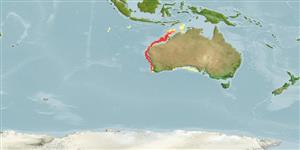Common names from other countries
Elasmobranchii (sharks and rays) >
Carcharhiniformes (Ground sharks) >
Triakidae (Houndsharks) > Triakinae
Etymology: Mustelus: Latin for weasel, an ancient name for sharks, possibly referring to the pointed snouts, swift movements and/or rapacious feeding behavior of smaller predatory sharks [strictly not tautonymous with Squalus mustelus Linnaeus 1758 since type was designated by the ICZN]. (See ETYFish); stevensi: In honor of John Stevens (b. 1947), Senior Principal Research Scientist, CSIRO Marine and Atmospheric Research (Australia), who has “dedicated a lifetime to researching sharks around the world, and who has contributed greatly to our knowledge of sharks and rays in Australia”. (See ETYFish).
More on authors: White & Last.
Environment: milieu / climate zone / depth range / distribution range
Ecology
Marine; benthopelagic; depth range 69 - 735 m (Ref. 124465). Tropical
Eastern Indian Ocean: tropical, from northwest Australia to southern Indonesia and the Andaman Sea.
Length at first maturity / Size / Weight / Age
Maturity: Lm 75.1, range 58 - 91.9 cm
Max length : 128 cm TL male/unsexed; (Ref. 124465); 103.4 cm TL (female)
Short description
Identification keys | Morphology | Morphometrics
This moderately large species is disinguished by the following characters: palatine processes of the
palatoquadrates not subdivided at the symphysis; pre-second dorsal length 58.1-61.4% TL; upper labial furrows are longer than lower furrows, upper ones 1.7-2.3% TL and 1.3-1.7 times lowers; buccopharyngeal denticles cover entire tongue and roof of mouth; reproductive mode aplacental viviparity; adults are without any hypercalcification of skeletal elements; dorsal fins moderately large and upright, first dorsal-fin anterior margin 13.0-15.7% TL, height 8.5-10.3% TL; claspers of adults are moderately long, inner length 8.1-11.2% TL; teeth in about 72/75 files; precaudal vertebral centra 75-91, monospondylous centra 33-41; small white spots usually present on the dorsal surfaces of body, including along lateral line; dorsal fins often with dark apical margins; caudal-fin terminal lobe white tipped (Ref. 124465).
Recorded litter size litter sizes of 5-17 pups with size at birth likely to be around 28.0 cm TL (Ref. 124465).
Life cycle and mating behavior
Maturities | Reproduction | Spawnings | Egg(s) | Fecundities | Larvae
White, W.T., S. Arunrugstichai and G.J.P. Naylor, 2021. Revision of the genus Mustelus (Carcharhiniformes: Triakidae) in the northern Indian Ocean, with description of a new species and a discussion on the validity of M. walkeri and M. ravidus. Mar. Biodiversity 51(42):1-24. (Ref. 124465)
IUCN Red List Status (Ref. 130435)
CITES (Ref. 128078)
Not Evaluated
Threat to humans
Harmless
Human uses
Tools
Special reports
Download XML
Internet sources
Estimates based on models
Preferred temperature (Ref.
115969): 13.5 - 20.4, mean 16.5 (based on 27 cells).
Phylogenetic diversity index (Ref.
82804): PD
50 = 0.5000 [Uniqueness, from 0.5 = low to 2.0 = high].
Bayesian length-weight: a=0.00224 (0.00105 - 0.00478), b=3.14 (2.97 - 3.31), in cm Total Length, based on LWR estimates for this Genus-body shape (Ref.
93245).
Trophic level (Ref.
69278): 3.7 ±0.4 se; based on size and trophs of closest relatives
Resilience (Ref.
120179): Low, minimum population doubling time 4.5 - 14 years (Preliminary K or Fecundity.).
Fishing Vulnerability (Ref.
59153): Very high vulnerability (77 of 100).
